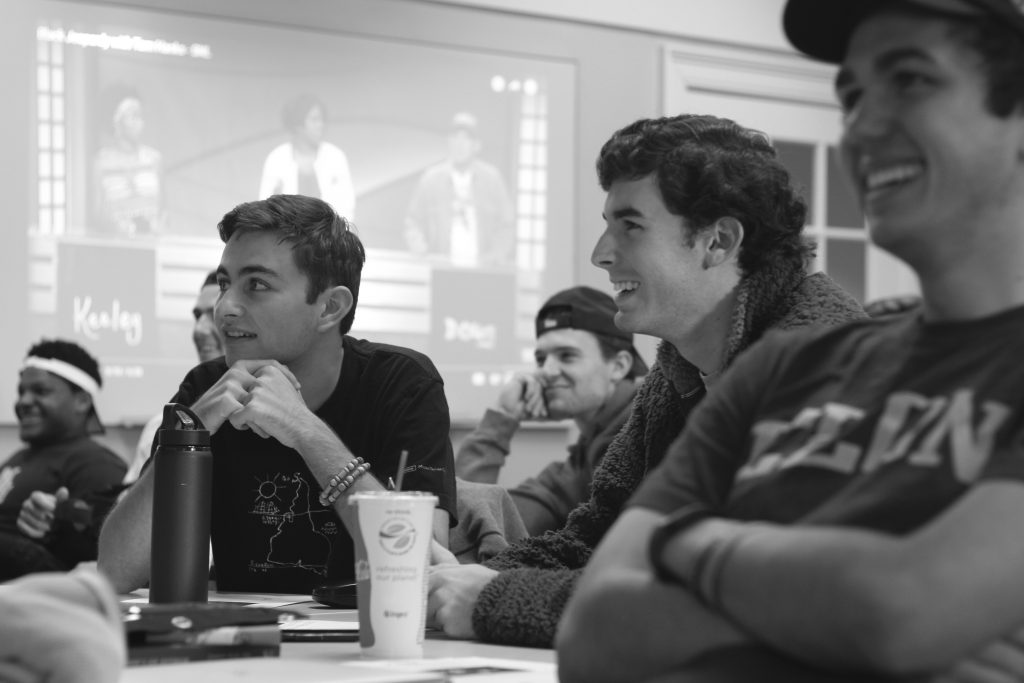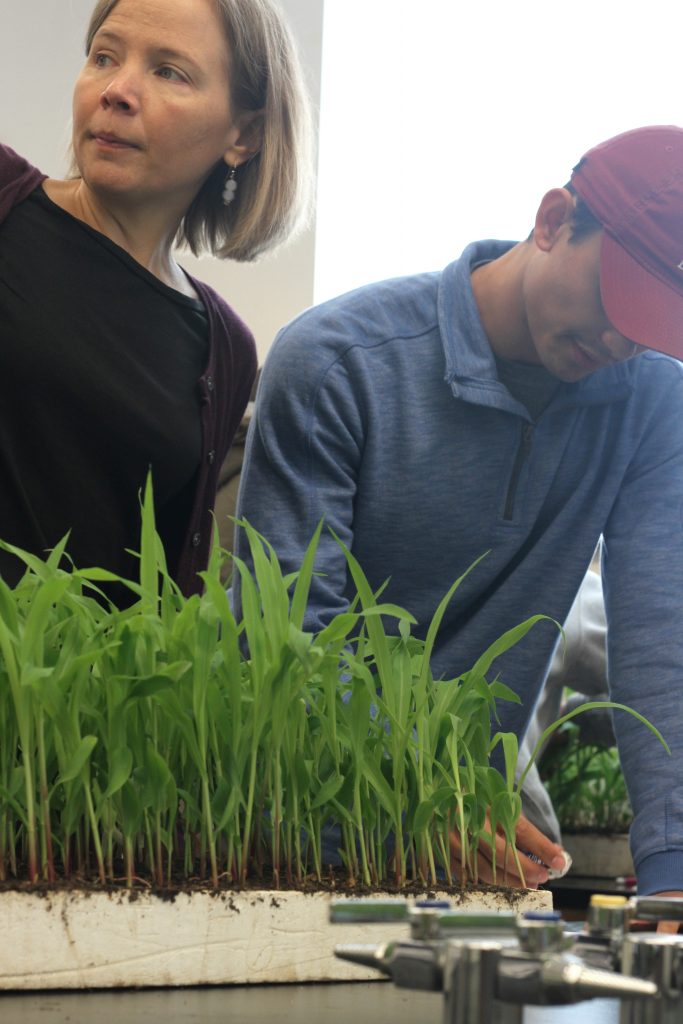- Home
- Center for the Advancement of Teaching & Learning
- Teaching & Learning Resources
- Creating a Classroom Climate to Support Learning
Creating a Classroom Climate to Support Learning
Creating a classroom climate to support learning
Classroom Climate and Student Learning
Research on college teaching shows that student perceptions of classroom climate “have a great impact on learning, motivation, satisfaction, and achievement” (Barr, 2016). A variety of intellectual, emotional, social and physical factors combine to determine class climate. Although individual students within a class may perceive climate differently, studies suggest that paying attention to the following factors can have a positive and broad effect on climate (Ambrose et al, 2010):

- Faculty-student interactions, communicating a supportive tone and rapport
- Student-student interactions in which there is sense of mutual respect
- Including a wide range of perspectives in course content and materials
Building Rapport
Relationship building between faculty and students can improve student perceptions of the course, improving discussion, student collaboration, and overall performance. Research suggests that positive interactions between students and faculty can also help support student well-being and mental health by reducing stressors. Many of the interpersonal skills (Frisby et al. 2014) that contribute to a positive climate and rapport are ones in our control: encouraging participation, listening, mutual respect, communicating concern for and interest in our students, and answering questions, among others.
The tone an instructor sets can also influence class climate: Does the syllabus explain policies and requirements in an inviting or a punitive manner? Does the instructor provide constructive feedback in ways that are encouraging or demotivating? Combined messages of challenge and support can go a long way toward communicating that you have high expectations for student work but that you believe students can reach those expectations with effort, support, and resources.
General tips for building rapport:
- Learn student names: HSS faculty member Sandra Reid explains, “It sounds elementary, but this is where it starts. It’s important for me to know who they are and to know something about them. In order for us to function as a community, they need to also learn each other’s names. There’s so much power in a name, naming, and who calls you what.”
- Look for intentional ways to humanize yourself that are both appropriate and comfortable for you. In class or office hours, you might a) self-disclose a relevant aspect of your life, education or hobbies with students, b) show students how you apply course materials in your own work and life, c) discuss how you struggled when first learning challenging material, or d) discuss studying or learning strategies you developed as a student. Choosing what, when, and how to share will depend on your comfort, teaching persona, and relevance.
- Demonstrate an interest in students’ academic success and problems.
- Examine your assumptions about students. Assumptions influence the way we interact with students, and can also have an effect on class climate and their learning, particularly when these assumptions activate stereotypes that can disrupt cognitive processes (Steele, 2011)
Resource: Barr’s (2016) white paper, “Developing a Positive Classroom Climate,” summarizes current research and provides insight and advice to instructors on ways to (and not to) build rapport and improve classroom climate.
Elon Professor Practices: Sandy Marshall (History & Geography)

I’m pretty intentional about community building right off the bat, in class the first week. This is important in terms of student health and well-being and institutional climate and also in laying groundwork for students to engage with content and each other.”
Building Community
Fostering a sense of community between students in the classroom can also contribute to a positive climate, creating an environment in which students take intellectual risks, prepare for and participate in class. One study suggests that environments where students feel connected may also discourage cheating and motivate learning (Bouville, 2010). The Motivation Research Institute notes that “when students experience meaningful student-student and student-teacher relationships, they are more likely to experience high value” and be motivated to learn.
Sandra Reid explains why this matters in her classes:
“It’s important for students to not be afraid or apprehensive, because we’ll be talking about a number of challenging concepts throughout the semester. In HSS, students must learn how to partner with people who have different challenges than they do, making relationship building not only important for the students in class, but also a core concept and skillset.” Planning an early community-building exercise means “students have engaged in problem-solving that both created community and connections to the course, so when we do have more controversial conversations they’ve already made a base level of connection in the classroom.”
General tips for building community:
- Establish norms or guidelines for class discussion or interactions. Discuss with students what kinds of rules or agreements you all need to follow in order to feel safe to share perspectives.
- Plan interactions that will get students actively engaged with the material and with each other. From the first week on, consider ways to balance small and large group discussions, use writable walls or collaborative technology to form groups and make the discussions visible.
- Anticipate sensitive issues or tensions and address or prepare for them.
- Turn discord and cognitive dissonance into a learning opportunity. Address tension directly by reminding students that disagreement and conflict are natural, and that to be productive, discussions or debates should be focused on issues rather than people. If a discussion becomes heated, take a moment to defuse the emotions so the group can discuss it. You might, for example, give students a moment to write or think individually after a particularly charged moment before returning to discuss the topic as a group. Or, ask students to consider a range of possible perspectives, evidence, or underlying assumptions to test a debated claim or argument.
Resource: You’ll find more strategies and resources for creating an effective and inclusive classroom climate on the website, “Classroom Climate,” Carnegie Mellon University’s Eberly Center for Teaching Excellence and Educational Innovation.
Building Connections
Helping students make connections between the course material and their prior knowledge, the world around them, or their future goals can help increase a sense of relevancy and motivation, which can in turn positively contribute to class climate and participation. Sandy Marshall, a faculty member in History and Geography, does this by planning activities that ask students to draw on their previous experience and triangulate that with course material and their own goals and expectations. In keeping with the previous suggestions to build rapport and community, Marshall advises, “I also always participate; I never ask students to do something I wouldn’t want to do — to avoid cringe-worthy moments.”
General tips for building connections:
- Connect course concepts to students’ prior knowledge and experience. Marshall describes how he does this on the first day of a Geography class with a practical problem-solving ice breaker he adapted from colleague Ryan Kirk: “Students first group according to regions of the US where they are from. The groups then divide the US into regions, drawing regional borders on a blank map of the country. As an ice breaking exercise, it is a fun way to meet other students from areas they are from while they are also admitting areas of the US they don’t know well & areas they do.” As students build connections with each other, they also reveal their own prior knowledge and assumptions in ways that the class can build on and interrogate.
- Connect course concepts to students’ personal or academic interests. Provide some choice or an entry point connected to students majors or goals. Another example from one of Marshall’s courses can be easily modified for courses in other disciplines: “Early on, after students have read an introduction to the discipline and heard me talk about what it means to think as a geographer, I ask them to form groups, share their names and majors and then come up with a geography research question related to their majors. In addition to introducing them to each other, this activity helps them see the relevance of the course to own major or profession.”
- Make connections between course material and the world outside of class, whether through cases, simulations, demonstrations or discussions of how experts use the theory, information, formula, or strategy in their work. Asking students to find or supply examples of these connections can help them begin to “see” your class in the world around them and engage more deeply as well.
- Connect to a range of examples or perspectives. Using multiple and diverse examples in class or selecting readings that do helps ensure that course content reflects the range of human experience and discovery and also does not marginalize students (Ambrose 2010).
Works Cited & Resources
Resources
- James Lang’s series of Chronicle articles on “Small Changes in Teaching” provide a number of simple but effective strategies that span across these three categories — Including, for example, the 3 tips in “Small Changes in Teaching: The minutes before class” among others. Each of the essays were adapted from his longer book, Small Teaching: Everyday Lessons from the Science of Teaching (2016), available in the CATL/CEL library.
- Kimberly Tanner’s (2013) article on why “Structure Matters” includes a list of 21 easy-to-implement teaching strategies that promote student engagement while cultivating a beneficial classroom climate (and has a handy checklist for “self-assessment of equitable teaching strategies” that you can use to reflect on what you are or could be incorporating.)
- Harvard’s School of Education has video resources on Building Community in the classroom, where professors share their thoughts on how students might develop conversations, take risks, and share ideas and experiences rather than rely on professors for answers to discussion questions.
*If you’d like some help developing plans or finding other research or resources specific to your teaching context, let us know; CATL faculty consultants would be happy to talk with you.
Works Cited
Ambrose, S. A., Bridges, M. W., DiPietro, M., Lovett, M. C., & Norman, M. K. (2010). How learning works: Seven research-based principles for smart teaching. John Wiley & Sons.
Barr, J. J. (2016). Developing a Positive Classroom Climate. IDEA Paper# 61. IDEA Center, Inc.
Bouville, M. (2010). Why is cheating wrong? Studies in Philosophy and Education, 29(1), 67–76.
Frisby, B. N., Berger, E., Burchett, M., Herovic, E., & Strawser, M. G. (2014). Participation apprehensive students: The influence of face support and instructor-student rapport on classroom participation. Communication Education, 63(2), 105–123.
Lang, J. M. (2015). Small changes in teaching: The minutes before class. The Chronicle of Higher Education.
Lang, J. M. (2016). Small teaching: Everyday lessons from the science of learning. John Wiley & Sons.
Steele, C. M. (2010). Whistling Vivaldi: How stereotypes affect us and what we can do. WW Norton & Co.
Tanner, K. D. (2013) Structure matters: Twenty-one teaching strategies to promote student engagement and cultivate classroom equity. CBE-Life Sciences Education, 12, 322-331.